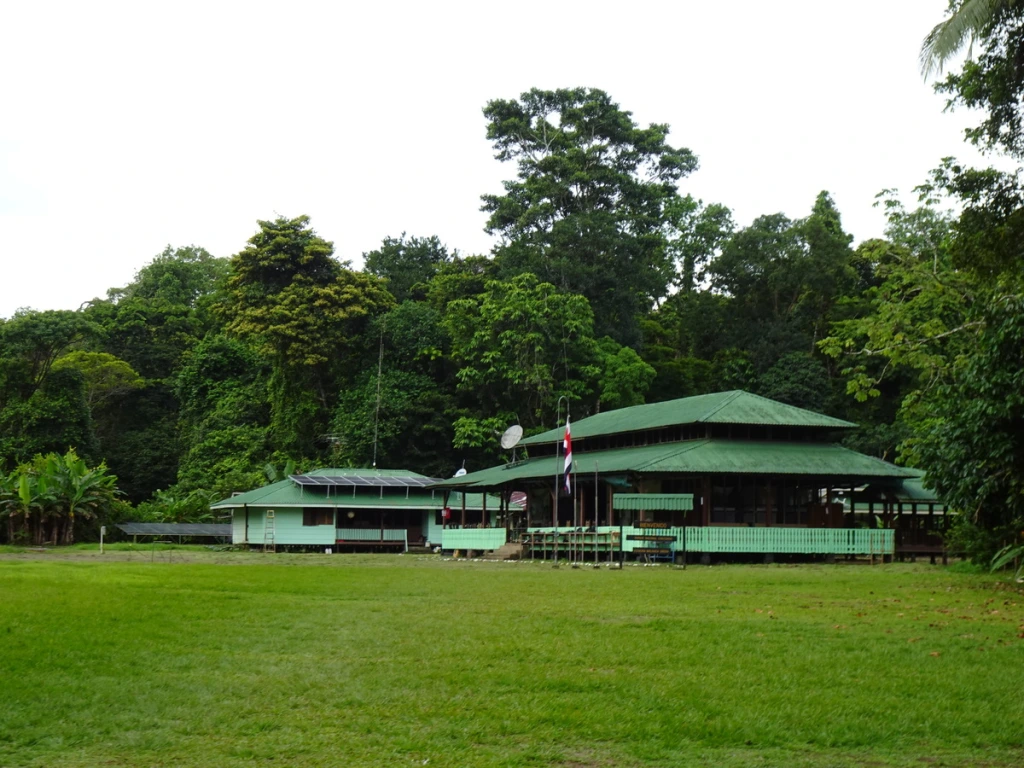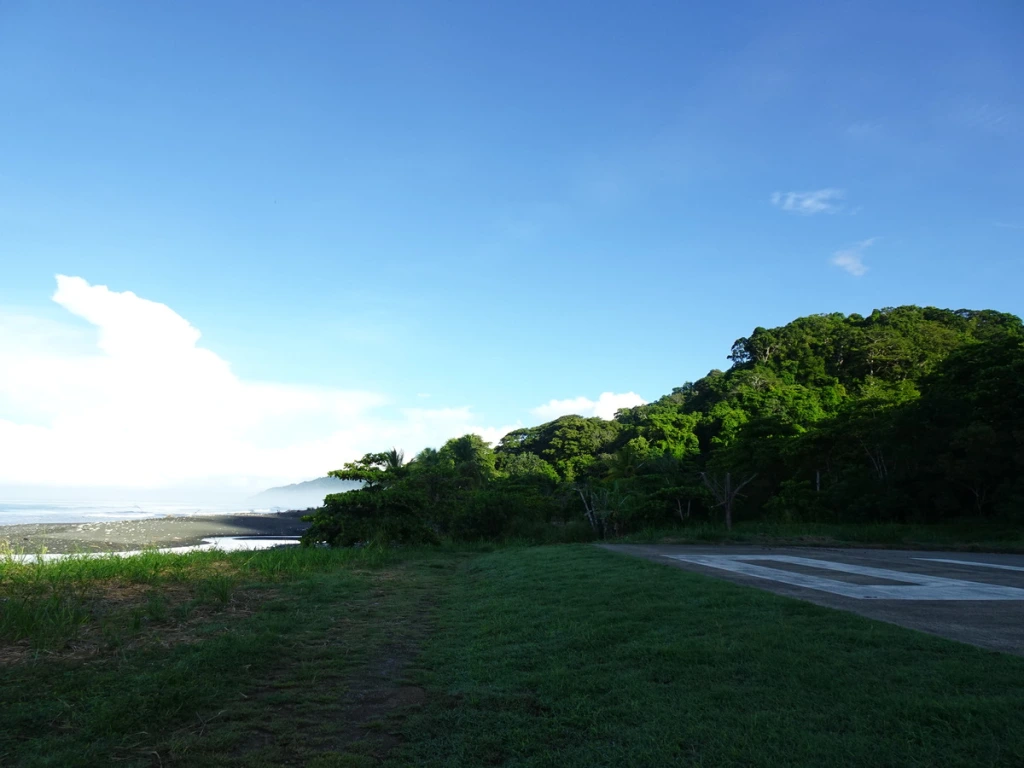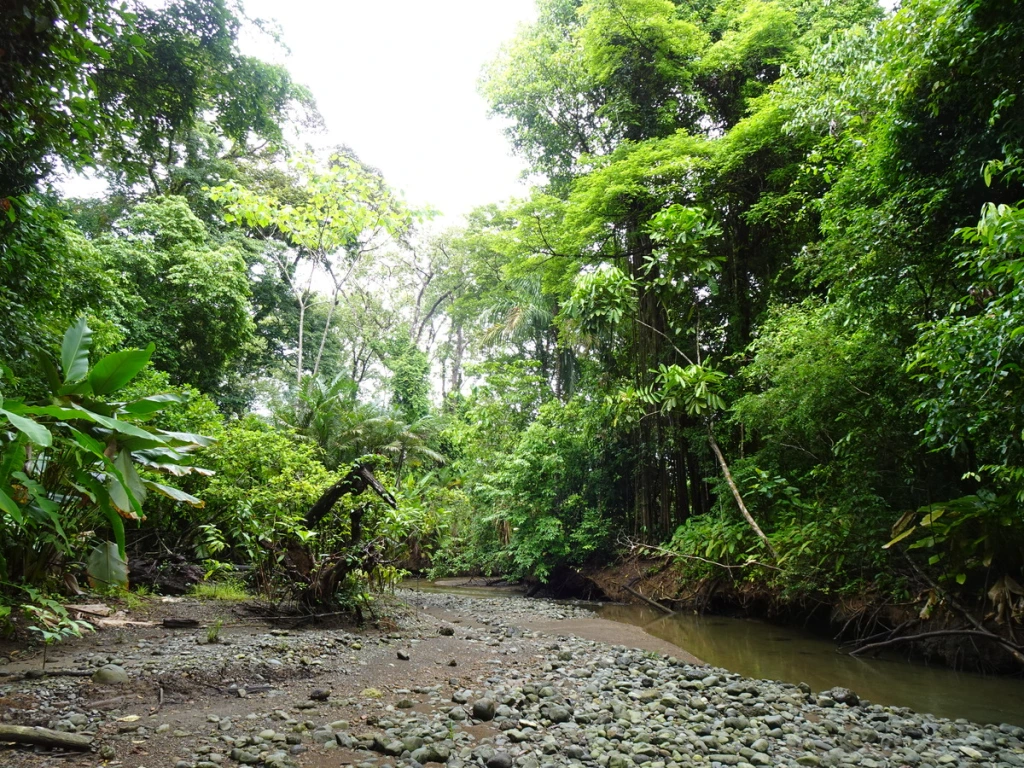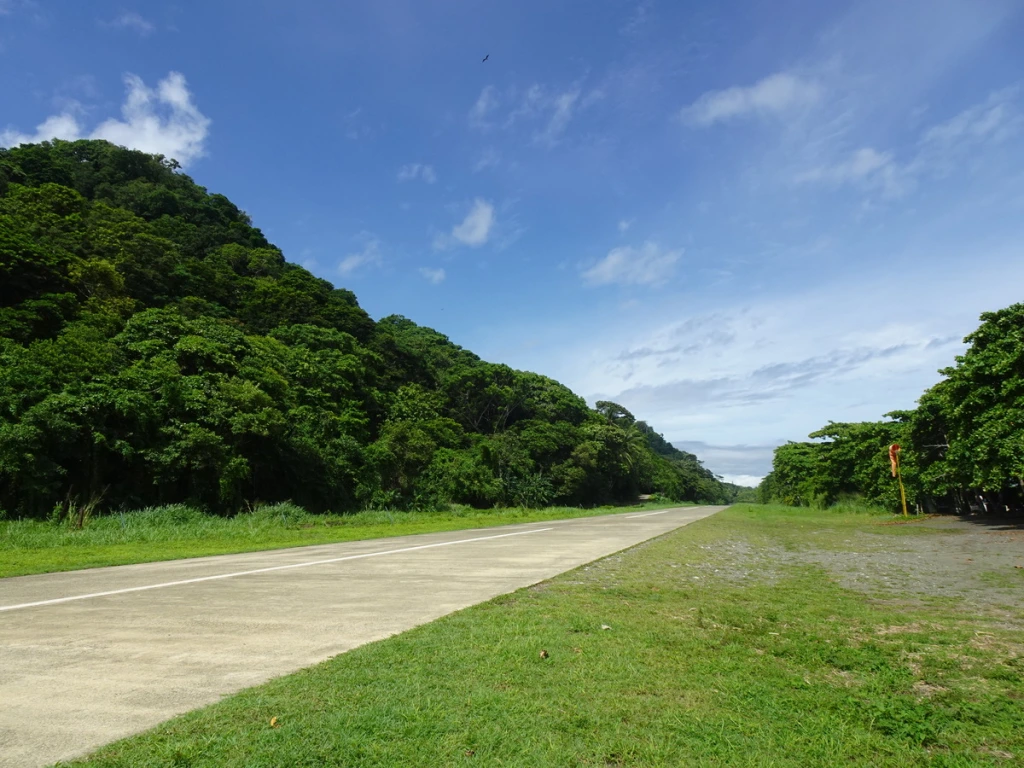Bigger doesn’t always mean better, but in Corcovado National Park’s case it most definitely does. Corcovado National Park spans 164 square miles and covers roughly a third of Costa Rica’s Osa Peninsula, a region that is home to 2.5% of the world’s (yes – not just Costa Rica’s, the world’s) biodiversity. Given you’re not visiting a zoo, there are no guarantees on what you will see – but you do have a seriously good chance of seeing a good number of Costa Rica’s furry and feathered residents. When planning our trip to Costa Rica, this was one of our non-negotiables. Hopefully, by the end of this post, you’ll be able to see why!
WHEN TO GO
The Osa Peninsula experiences a tropical climate with rain year-round. Whilst most guidebooks recommend going in the dry season (late December to April) for optimal trail conditions, if you don’t have the luxury of scheduling your trip to coincide with this, fear not. We hiked in Corcovado National Park in mid-July, and the trail from Carate to Sirena Ranger Station was absolutely fine. There was heavy rain one afternoon and a storm overnight while we were there, but the paths were in good condition. Our guide did, however, advise that Osa Wild (and, presumably, other tour operators) do not run tours in October, when the rains are heaviest, and that the route from Los Patos to Sirena Ranger Station is best saved for the dry season.
~2-3 MONTHS BEFORE
You must be accompanied by a licensed guide during your time in Corcovado National Park. Once you’ve figured out roughly which dates you want, make reserving a tour a priority so you don’t miss out. We booked through Osa Wild, a local company with a strong emphasis on sustainability, and I would highly recommend them. We paid USD$607 each (in May 2023, for our trip in July 2023) for their Corcovado Standard Package, which included:
- entrance fees to the park (Osa Wild take care of organising these, so that takes one item off your to-do list);
- a licensed, local guide (our guide, Ángel, was brilliant);
- shared transport from Puerto Jiménez to Carate (and back again);
- a two-night stay at Sirena Ranger Station. You’ll be assigned to a bunk in a shared dorm (there’s a roof to protect you from the rain, but no walls), and there are shared toilets/shower facilities;
- breakfast (x2) and dinner (x2).
We were expecting to be part of a small group (2-6), but it turned out that no-one else had booked the same dates as us. We therefore ended up with a private tour – just the two of us plus our guide – which was incredible. Lunch cost USD$15 per person, and we paid for this when we arrived at Sirena Ranger Station. You can also purchase light refreshments from the on-site shop.

WHAT TO PACK
Corcovado National Park is hot and humid, so pack accordingly: light, breathable clothing is your friend. Here’s what I took (clothes-wise) on this portion of our trip:
- A couple of thin, lightweight T-shirts (I like the lightweight running ones from Decathlon);
- A pair of zip-off hiking trousers (mine are from The North Face, and are still going strong six years on);
- Sports bra, pants;
- Socks (I usually wear a thin pair and a thick pair, and packed enough to start each day with dry socks);
- A T-shirt and leggings (to sleep in);
- Waterproof coat;
- Sturdy hiking boots;
- Flip flops (for the showers and pottering around Sirena Ranger Station).
A hat would have come in handy on the exposed beaches, but I managed without one. We were able to store some of our belongings at Cabinas Jiménez, and this was super helpful for two reasons:
- The hike from Carate to Sirena Ranger Station is 20km, give or take, and it meant we could shave some weight off our packs;
- Pretty much everything that we took into Corcovado National Park came back feeling damp (partly due to the river crossing, but partly due to the humidity).
So, if you have the option to leave belongings securely at your accommodation, do it.
You’ll also want to pack sunblock, insect repellent (we took a bottle of Smidge with us) and plenty of snacks for the hikes in and out (note that these cannot be consumed at, or in the vicinity of, Sirena Ranger Station). Single-use plastics are banned in Corcovado National Park, so you’ll need to bring reusable water bottles with you. We had binoculars with us, but to be honest our guide’s scope was infinitely better. You can rent towels from Sirena Ranger Station.
THE DAY BEFORE
Stock up on snacks at BM Jiménez, the supermarket in Puerto Jiménez. We were also advised to (and did) swing by Osa Wild to confirm our pick-up location and time. This was also a good chance to get up-to-date information on trail conditions and the weather forecast.

DAY 1: CARATE TO SIRENA RANGER STATION
Distance | 24.14km / 15 miles. Either my Garmin was wildly off the mark for the elevation gain (more likely), or it’s the flattest-looking trail with 1,279m elevation gain I’ve ever seen. I think the GPS was a bit off on my watch (the signal was quite poor), as it’s supposedly around the 20km mark. This took us approx. 9hrs 45 minutes (including a lot of photo stops).
Our alarms buzzed us awake at 04.20. The early bird catches the worm… or the bumpy ride to Carate, as the case may be! We met our guide, Ángel, outside Hellen’s Chill House at 05.20. We pulled up at the end of a small airstrip about an hour later and promptly set off for La Leona Ranger Station, a 3.5km walk away along the coast. The path weaves between the fringes of the tropical forest and a sandy, deserted beach. (Sounds idyllic? It is, but the humidity is an absolute beast.)
Tides dictate this route: off came our boots at one point so we could wade round some rocks, and Plan B came into play at another where the sea had already come in. Within 1km, we had seen three of Costa Rica’s four species of monkey: the agile spider monkey, the hear-it-before-you-see-it howler monkey, and the cute capuchin monkey (also referred to as carablanca, or white-faced monkey, in Central America). Only the speedy squirrel monkey eluded us (for now, at least).
We had wondered whether we would be missing out by doing the Carate to Sirena Ranger Station route in both directions (rather than entering Corcovado National Park via the Los Patos to Sirena Ranger Station route), but Ángel told us that the coastal route is much better for wildlife-spotting.
At times, the path drifted away from the sandy shores and into the edge of the tropical forest, giving us temporary relief from the sun.
Ángel identified various birds for us, and even found a Golfo Dulce poison-dart frog tucked beneath some dead leaves (which is endemic to Costa Rica, and only found in and around Corcovado National Park). Several pairs of scarlet macaws soared above us, and a pod of pelicans took off to our left. We saw a few bands of coatis, including one with lots of little ‘uns, but the best (and worst) was yet to come.
The best bit? We had just crossed the toughest of the beaches – a long stretch of sand with zero shade – and as we rounded a bend (pictured above), we spotted a juvenile Baird’s tapir snoozing on the sand. It was utterly adorable, and neither of us could quite believe our luck. We were probably within five metres or so of this little guy (a distance dictated by the receding tide).
The worst bit? The amount of plastic that had washed up on the shore behind said tapir: mostly water bottles and plastic packaging, but also Crocs, assorted sandals and a football. Even somewhere as beautiful as Corcovado National Park can’t escape the poor choices made by humans elsewhere.
This route involves a river crossing, which was something we were both a little apprehensive about for a number of reasons. Neither of us particularly enjoy river crossings in Scotland, where the water is usually cold and often fast flowing. The couple we had met on our journey to San Gerardo de Rivas had told us the water was up to their chests when they had done this hike a couple of weeks previously. (As they were both taller than us, that wasn’t especially reassuring news!) Corcovado National Park’s rivers and lagoons are also home to crocodiles, caiman and sharks. Fortunately, we didn’t meet any of them.
Ángel suggested we take a longer lunch break and wait out high tide, as this would enable us to cross Río Claro when the water was a little lower. We were only too happy to take him up on this. After lunch, Ángel led us to the crossing point. It’s about twenty metres or so across. When we crossed, the water came up to our waist (making it roughly a metre deep), and our rucksacks just about stayed dry (though I had packed the contents of my bag into a dry sack to be on the safe side).
Take your socks and boots off, and tie your boots securely to your rucksack;
Unclip your rucksack at the waist/chest (so that if you fall, you can remove it more easily and it won’t weigh you down);
Follow your guide across the river: we took it slow and steady, so we didn’t lose our footing.
I have to admit that the river crossing did feel very refreshing after a long sweaty walk, even if our clothes never dried out fully after it. Once things get wet here, they tend to stay that way. From this point, it’s only a half-hour walk to Sirena Ranger Station. When we arrived, we were given a bottle of soursop (guanábana) juice as a welcome drink. Contrary to its name, it was sweet and very tasty! We treated ourselves to cookies (the coconut and ginger ones were particularly good) and paid for lunch for the following day (both card and cash accepted).
After showering and settling into our accommodation, we chatted to Ángel on the deck before tea – a hefty plate of rice, beans, vegetables, fish and salad, followed by a caramel-y dessert and another cup of soursop juice.
DAY 2: AROUND SIRENA RANGER STATION
We woke up to thunder, lightning and heavy rain. Plan A (a walk before breakfast, to maximise our chances of seeing some of the nocturnal creatures) swiftly went out the window. We headed back to bed, and agreed to meet Ángel for breakfast at 06.15. As a picky eater, I found Sirena Ranger Station was more flexible than I had anticipated: if there was something you didn’t want, it didn’t need to go on your plate. Laurence fuelled up on gallo pinto (refried rice and beans, served with diced vegetables and eggs), while I opted for bread and plenty of fresh fruit (melon, watermelon, pineapple) washed down with a mug of tea and more soursop juice.
For our first walk, Ángel took us along the Sendero Sirena. Although there had been a lot of rain overnight, the trails didn’t seem particularly muddy. We saw a coati as we crossed the airstrip, and then some agouti in the forest. These were very cute little creatures, but they seemed exceptionally camera shy: they darted off almost as soon as we had seen them, and I didn’t manage to take a half-decent photo of them until we saw them again in Santa Elena, at the end of our trip. We also spotted some cute little bats clinging to the edge of a tree trunk; they blended in remarkably well against the bark.

Further on, we caught a glimpse of the squirrel monkeys, the smallest of Costa Rica’s four species of monkey. They scampered nimbly along the branches above our heads, and were so speedy that taking a non-fuzzy photo proved challenging!
Up ahead, we joined some other groups to watch a Baird’s tapir crossing a stream (it then plonked itself in a swamp, so I don’t have any photos of it) and play spot the silky anteater (it disappeared up a tree and sadly didn’t re-emerge). We returned to Sirena Ranger Station around 11.00, by which point the area was busy with day trippers arriving by boat from Bahía Drake (Drake Bay) and Puerto Jiménez. Almost as soon as we returned, the heavens opened once again – so we timed that perfectly!
We had an early lunch – more rice, beans and vegetables, this time served with pork ribs, and followed by fresh mango and watermelon (apparently these are sweeter during the dry season, but to us they were still considerably better than those we’d find on the shelves of our local supermarket). We then had a couple of hours to chill; as it’s so hot and humid many of the animals take a siesta, so there is little point venturing out in the heat of the day. Instead, we sat on the deck and enjoyed watching the spider monkeys feast on fruit from the nearby trees.
We set off on another hike with Ángel around 14.00, this time in the direction of Río Claro (the river we had crossed the previous day). Further into the forest, we saw howler monkeys and another troop of squirrel monkeys. As this route retraced (some of) our steps from yesterday, we enjoyed another viewing of the sloth through Ángel’s scope, still curled up high in the treetops. (They are very sweet balls of fluff, but if you want to see sloths close up La Perica Sloth Garden is the place to go.)
As we crossed the beach at the foot of the airstrip, the rain resumed (and quickly turned into a deluge). We were soaked to the skin by the time we reached Sirena Ranger Station, fewer than fifty metres away, and despite liberally applying Smidge before each of our hikes I was covered in mosquito bites from the knee down. (On the upside, they didn’t itch anywhere near as much as a midge bite here in Scotland does!)
We had (you guessed it) another helping of rice, beans and vegetables, accompanied by cinnamon-y potatoes and chicken for tea. Tonight’s dessert was a generous slab of passionfruit cheesecake (yum!).
DAY 3: SIRENA RANGER STATION TO CARATE
Distance | 22.67km / 14.1 miles. As mentioned previously, I think the GPS on my watch was a little off: the distance should be closer to the 20km mark. This took us approx. 8hrs 30 minutes, with lots of stops for wildlife-watching along the way.
We woke up at 04.30: an early start meant we would reach each of the three river crossings at low tide (or as close to it as possible). We met Ángel for coffee, and he collected our breakfast bags (each containing a tub of rice, beans and plantain, plus a square of cake and a carton of juice). We set off at dawn (approx. 05.00), with the sky brightening the closer we came to Río Claro. This time, it was much easier to cross for two reasons:
- We didn’t have to cross the full width of the river. At low tide, a bank protrudes into the river, significantly shortening the river crossing;
- The water only came up to our knees, so wading through it wasn’t so hard-going.
A couple of hours in (after we had crossed the big beach, which was much more manageable on our return in the morning than in the midday sun on our outward journey), we stopped for breakfast. A group of Mexicans were also hiking back today, and we crossed paths several times en route to Carate. We saw plenty of spider monkeys along the coast, alongside a turtle nest that had been raided by coati. Crabs were polishing off the shells that remained. Ángel estimated that the eggs had been laid recently – perhaps a week ago – as the turtle’s tracks were still visible in the sand.
We arrived back in Carate around 14.00. After a short wait, we all piled into the pick-up, and with more weight in it (our small group, plus the Mexicans and their Osa Wild guide) the potholes and bumpy road didn’t feel anywhere near as puke-inducing as it had a couple of days prior.

Back in Puerto Jiménez, our first stop was Café Monka for a cold drink… swiftly followed by Cabinas Jiménez for a hot shower! My photos don’t really do Corcovado National Park justice: it’s surprisingly dark in the tropical forest and some of the animals move quickly, making it difficult to take many decent photos. To be honest, I think most of the magic of this place lies in enjoying it in the moment.